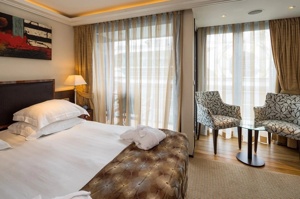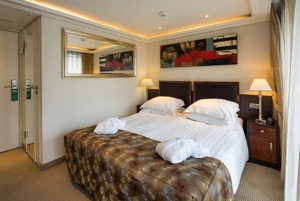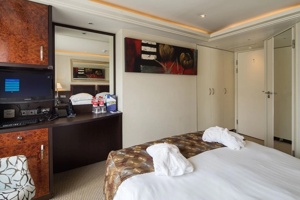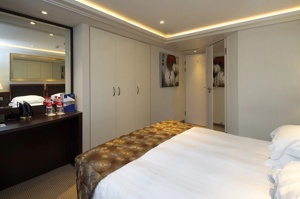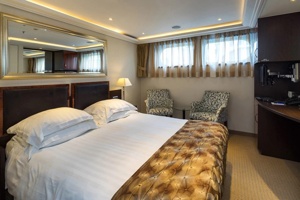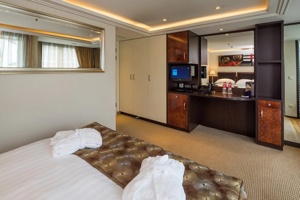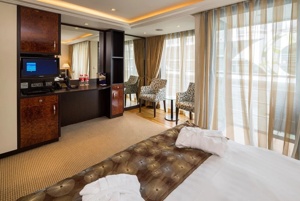One of AmaWaterways' remarkable twin-balcony river ships, the newly reimagined AmaVerde, is full of light, love and bold artwork showcasing vibrant, modern designs. The dashing ship is considered the captivating companion of the AmaBella as both ships were totally redesigned in 2021 and sail their imagined love story on the romantic Danube River. Spacious, sophisticated staterooms set the mind at ease for a restful slumber, while warmth attracts visitors to the comfortable fireside library and AmaVerde's massage and hair salon. The Main Restaurant is the perfect home to exquisite meals and local wine pairings worthy of La Chaîne des Rôtisseurs — the internationally renowned gastronomic society. The Chef's Table specialty restaurant, with its glass-enclosed kitchen and unique rolled lighting fixture, gives way to a vibrant multi-course parade of dishes with distinct regional flavors paired with hand selected wines. Enjoy a light lunch in our new “Café Bistro,” a perfect al fresco spot to play cards and mingle with your fellow guests. Additional amenities on AmaVerde include unlimited high-quality complimentary Wi-Fi, movies, music and English-language TV stations in the staterooms, a specialty coffee station, gift shop, sun-deck walking track, heated swimming pool, putting green, fitness room and fleet of bikes.
Cruise ID: 53266
With AmaWaterways, you have the option of exploring Europe's amazing sights like the locals do. We were the first river cruise line to carry an entire fleet of complimentary bicycles on board, so you can experience biking alongside enchanting riverside pathways and in city centres. Whether you feel like joining one of our exclusive guided bike tours, or want to go discover on your own, there are many ways for you to explore on two wheels during your cruise.
EUROPE
7-Night Cruise
Ship's Crew: The entire amount will be divided equally amongst all crew members. Recommendation: 100 Euros per 7-night cruise, per guest. (AmaMagna 120 Euros per 7-night cruise, per guest)
Cruise Manager: Your Cruise Manager is not part of the ship's crew and is the AmaWaterways representative who also accompanies you on any pre- and/or post-cruise hotel/land extensions you may have booked. Recommendation: 25 Euros per 7-night, per guest; 4 Euros for each additional day, per guest for pre- and post-cruise hotel/land extensions.
10-Night Cruise
Ship's Crew: The entire amount will be divided equally amongst all crew members. Recommendation: 143 Euros per 10-night cruise, per guest.
Cruise Manager: Your Cruise Manager is not part of the ship's crew and is the AmaWaterways representative who also accompanies you on any pre- and/or post-cruise hotel/land extensions you may have booked. Recommendation: 36 Euros per 10-night, per guest; 4 Euros for each additional day, per guest for pre- and post-cruise hotel/land extensions.
11-Night Cruise
Ship's Crew: The entire amount will be divided equally amongst all crew members. Recommendation: 158 Euros per 11-night cruise, per guest.
Cruise Manager: Your Cruise Manager is not part of the ship's crew and is the AmaWaterways representative who also accompanies you on any pre- and/or post-cruise hotel/land extensions you may have booked. Recommendation: 40 Euros per 11-night, per guest; 4 Euros for each additional day, per guest for pre- and post-cruise hotel/land extensions.
14-Night Cruise
Ship's Crew: The entire amount will be divided equally amongst all crew members. Recommendation: 200 Euros per 14-night cruise, per guest.
Cruise Manager: Your Cruise Manager is not part of the ship's crew and is the AmaWaterways representative who also accompanies you on any pre- and/or post-cruise hotel/land extensions you may have booked. Recommendation: 50 Euros per 14-night, per guest; 4 Euros for each additional day, per guest for pre- and post-cruise hotel/land extensions.



